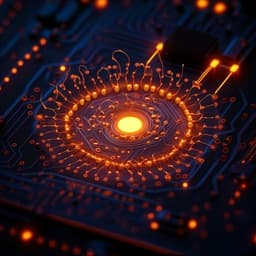
Physics
Easy-plane Spin Hall Oscillator
E. A. Montoya, A. Khan, et al.
Discover the exciting advancements in Spin Hall oscillators (SHOs) developed by Eric Arturo Montoya and colleagues! Their research reveals an innovative SHO design that enhances microwave power, making it a potential game-changer for wireless communications and neuromorphic computing.
~3 min • Beginner • English
Introduction
The study addresses how to increase the microwave output power of spin Hall oscillators (SHOs) by enabling large-amplitude magnetization dynamics using spin-orbit torques. Conventional SHOs, based on FM|HM bilayers, typically exhibit moderate precession amplitudes limited by nonlinear damping. Theory predicts that easy-plane (EP) ferromagnets driven by spin current polarized normal to the easy plane can support near-90° precession and operate without external magnetic field. The authors propose and realize an EP-SHO where the magnetic easy plane is the xz-plane (defined by the nanowire axis and film normal), produced by balancing perpendicular magnetic anisotropy (PMA) and shape anisotropy. The work aims to experimentally validate EP-SHO operation, quantify power enhancement versus standard SHO (S-SHO) operation, and compare with micromagnetic simulations, with significance for compact, tunable microwave sources and neuromorphic spiking devices.
Literature Review
Prior work established SOT-based devices including SOT-MRAM, oscillators, and magnonic logic, and SHOs as platforms for nonlinear magnetization dynamics. Conventional SHOs exhibit elliptical precession with amplitudes typically under ~20° due to nonlinear damping. Theoretical studies predicted that EP ferromagnets with spin polarization normal to the easy plane exhibit immediate large-amplitude precession above threshold and can function as spiking neurons, generating large output pulses for supra-threshold inputs. Large-amplitude EP dynamics were previously explored in spin-transfer torque nanopillar devices but not realized in SOT-based SHOs. Other studies addressed nonlinear damping control via PMA tuning and demonstrated constraints of geometries (e.g., discs) for achieving an artificial easy xz-plane. Additionally, power scaling strategies in STOs involve increasing oscillation amplitude, conversion efficiency (e.g., TMR readout), and phase locking; these have been exemplified in spin-transfer torque oscillators and in synchronized SHO arrays.
Methodology
- Device fabrication: Multilayers deposited by dc magnetron sputtering on Al2O3(0001) with Ta seed (3 nm) | Pt (7 nm) HM | [Co(0.98 nm)|Ni(1.46 nm)]2 | Co(0.98 nm) FM superlattice | Ta cap (4 nm). Ta(5 nm)|Au(40 nm)|Ta(5 nm) leads. Nanowires patterned via e-beam lithography and Ar+ ion milling to 50 nm width, 40 µm length. Active region length defined by lead spacing (50–450 nm); the studied device has l = 145 nm.
- Magnetic characterization: Broadband FMR prior to patterning used to extract saturation magnetization Ms = 997 kA/m and tune PMA near compensation of out-of-plane demagnetization at room temperature; PMA increases ~12% upon cooling to 4.2 K.
- Shape anisotropy: Demagnetization factors for the rectangular cross-section nanowire: Dx = 1.4×10^-4, Dy = 0.121, Dz = 0.879, giving demag fields H_Dy ≈ 1.52 kOe (µ0H_Dy = 152 mT) (hard y-axis), H_Dz ≈ 11.0 kOe (µ0H_Dz = 1.10 T). Achieving an easy xz-plane requires HPMA ≥ H_Dz.
- Experimental setup: Microwave emission measured at T = 4.2 K in He flow cryostat. Direct current Idc applied via bias tee; emitted microwave signal amplified (45 dB) and analyzed by a spectrum analyzer. Power values reported are delivered to a 50 Ω load with circuit calibration. Resistance oscillation amplitude δRac computed from measured integrated power P using δRac = sqrt(R50) [ (2P)^(1/2) / (Idc) ] with full expression provided in the text (mismatch model).
- Operating configurations: S-SHO measured with in-plane field H = 2.2 kOe (µ0H = 220 mT) at φ⊥ = 68°, θ⊥ = 90°. EP-SHO measured in low field H = 140 Oe (µ0H = 14 mT) at φ⊥ = 188°, θ⊥ = 90°; Joule heating tunes PMA to realize perfect easy xz-plane near a specific Idc.
- Micromagnetic simulations: Conducted with MuMax3 at T = 0 K for a 4 µm × 50 nm × 5.85 nm FM nanowire (2048×16×1 cells). Parameters: Ms = 997 kA/m, α = 0.027, g = 2.18, exchange A = 10 pJ/m, spin Hall angle θSH = 0.07. Spin Hall torque applied only in the 145 nm active region; includes Oersted field (≈66.9 Oe per mA Idc) and Joule-heating-induced reduction of HPMA in the active region with slope −494 Oe/mA (−4.94 T/A). Outside the active region, HPMA = 11.7 kOe (µ0HPMA = 1.17 T). Resistance dynamics computed from AMR and SMR contributions: Ra(t) = ΔRAMR⟨mx^2⟩ − ΔRSMR⟨my^2⟩ with ΔRAMR = ΔRSMR = 0.4 Ω. For EP-SHO, time-domain analysis used due to simulated bistability between dynamic and static states.
Key Findings
- EP-SHO realization: By tuning PMA and shape anisotropy in a Pt|CoNi nanowire, an artificial easy xz-plane anisotropy is achieved, enabling large-amplitude dynamics driven by spin Hall torque with near-zero external field.
- Power enhancement: EP-SHO maximum microwave power P ≈ 217 pW at Idc ≈ 2.39 mA (H = 140 Oe), significantly higher than S-SHO maximum P ≈ 74 pW near Idc ≈ 2.15 mA (H = 2.2 kOe), a ~3× increase for the same geometry.
- Frequency behavior: S-SHO shows blue shift with increasing Idc above Ic ≈ 1 mA. EP-SHO shows initial red shift to a minimum frequency ≈ 0.78 GHz at Idc ≈ 2.44 mA, then blue shifts for higher Idc. Second and third harmonics of the main mode are observed in EP-SHO, indicative of large-amplitude nonlinear oscillations.
- Joule heating control: PMA decreases with Idc due to heating, rotating the easy axis within the xz-plane from z- to x-dominant as Idc increases. Perfect easy-plane (HPMA = HDz) occurs near Idc ≈ 2.5 mA, coinciding with maximum oscillation amplitude and power.
- Resistance oscillations: δRac increases non-monotonically and peaks near the perfect easy-plane condition in EP-SHO. In S-SHO, δRac peaks then decreases at higher currents, consistent with nonlinear magnon scattering.
- Simulations: Qualitatively reproduce experimental trends. EP-SHO simulated frequencies closely match experiment versus Idc. Simulations predict bistability (dynamic/static) in EP-SHO, potential for random telegraph switching. Simulated δRac is maximized near the frequency minimum. S-SHO simulations show blue shift at higher Idc and increasing amplitude absent thermal effects.
- Additional quantitative details: Demagnetizing factors Dx = 1.4×10^-4, Dy = 0.121, Dz = 0.879 giving µ0HDz ≈ 1.10 T; Ms ≈ 997 kA/m; Oersted field ≈ 66.9 Oe/mA; heating slope of HPMA ≈ −494 Oe/mA.
Discussion
The work demonstrates that engineering an easy xz-plane anisotropy in a nanowire SHO enables large-amplitude auto-oscillations immediately above threshold, boosting microwave power output relative to conventional high-field SHO operation. The EP-SHO operates with minimal external field and leverages Joule-heating control of PMA to tune the energy landscape; the maximum power coincides with the perfect easy-plane condition (HPMA = HDz), validating the design principle. The findings directly address the challenge of achieving high output power by increasing oscillation amplitude and suggest suitability for spiking neuron behavior (thresholding and large responses), consistent with theoretical proposals. Discrepancies between experiment and simulation (e.g., higher experimental oscillation amplitude and frequency offsets) are explained by real-device effects: inter-grain exchange weakening, magnetic edge modifications, and thermal magnons not included in zero-temperature simulations. The excursion into −y enhances SMR contributions and fundamental-frequency power; in contrast, an ideal EP-SHO would emphasize strong second-harmonic emission via AMR. The authors discuss pathways to further enhance performance: higher conversion efficiency using TMR readout in 3-terminal geometries, and power scaling via mutual phase locking in SHO arrays. The EP nanowire platform may also support spin superfluid transport in future designs with reduced PMA temperature sensitivity.
Conclusion
This work reports the first experimental realization of an easy-plane spin Hall oscillator (EP-SHO) in a Pt|CoNi nanowire, operating at near-zero magnetic field and delivering significantly enhanced microwave power due to large-amplitude resistance auto-oscillations driven by spin Hall torque. The easy-plane anisotropy perpendicular to the film plane is engineered by balancing nanowire shape anisotropy with interfacial PMA and tuned via Joule heating. Micromagnetic simulations qualitatively agree with measurements and accurately capture the frequency versus current behavior. The EP-SHO concept enables practical high-power SOT oscillators and is promising for spintronic spiking neurons. Future research directions include mitigating bistability, incorporating high magnetoresistance TMR readout in 3-terminal devices, optimizing materials with weaker PMA temperature dependence to enable spin superfluid states, and integrating phase-locked SHO arrays to reach ultimate power levels.
Limitations
- Simulations performed at T = 0 K do not include thermal magnons, leading to differences in amplitude trends at high current compared to experiment.
- Bistability between dynamic and static states predicted in EP-SHO regime may cause random telegraph switching, detrimental to coherent microwave output.
- Spatial inhomogeneity of PMA due to Ohmic heating in the active region precludes realization of spin superfluid states in the present design.
- Frequency discrepancies between experiment and simulations attributed to non-ideal magnetic edges (edge roughness/dilution) not captured in the model.
- Experimental operation demonstrated at cryogenic temperature (4.2 K); PMA and performance may vary at higher temperatures.
- In simulations, strong exchange coupling to static magnetization outside the active region limits dynamics to +z half-space; real films may have weaker inter-grain exchange.
Related Publications
Explore these studies to deepen your understanding of the subject.







